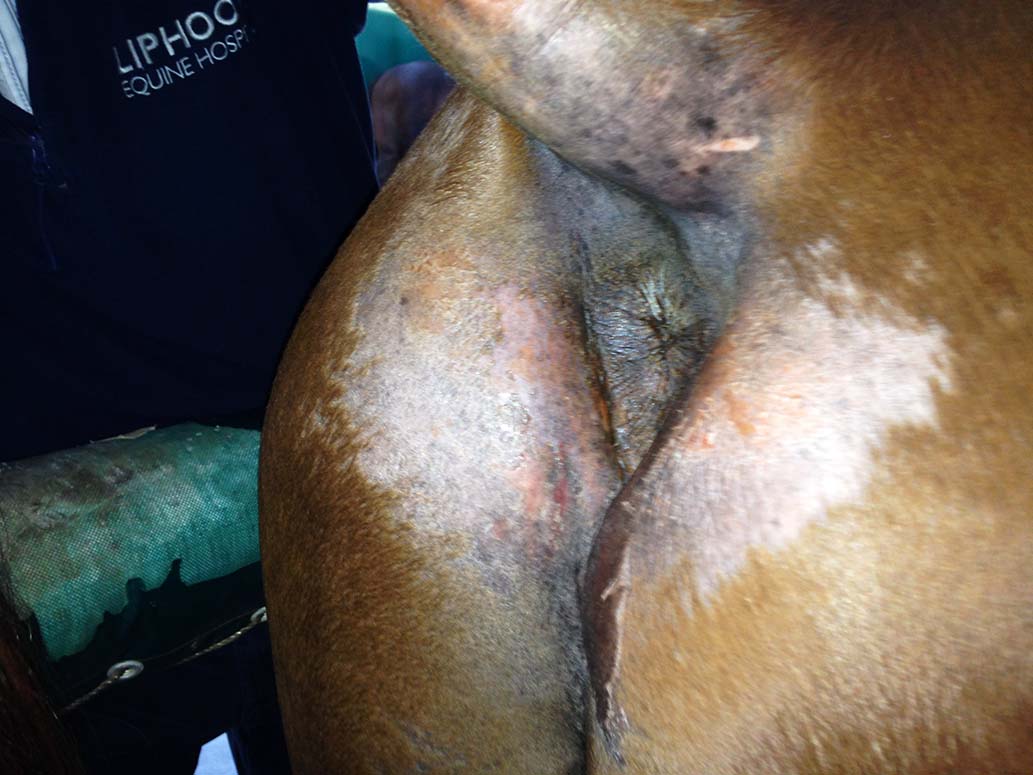10 Sept 2024
Andy Durham looks at the choices on offer to help treat acute and debilitating skin diseases in horses and ponies.

Image © vprotastchik/ Adobe Stock.
Skin disease appears to be the most commonly recorded equine health complaint by horse owners and carers1, although cases presenting to veterinary surgeons in practice might only be the tip of the iceberg.
Acute pruritus is a beneficial physiological sensation signalling the need to react to and remove biting insects or other irritants. In contrast, chronic pruritus is a pathologic state where the intended warning function is lost, and it becomes an unpleasant distraction unhelpful to resolving the underlying cause.
Although chronic pruritus is a clinical sign, it also has its own significance deserving of attention as a specific entity. Negative welfare consequences of chronic pruritus are substantial and it has been described as one of the most burdensome diseases in human patients, with an even greater impact on quality of life than stroke2.
In equids, pruritus generally results from either parasitism, for example, lice, pinworm or chorioptic mange, or allergy, such as insect bite hypersensitivity and atopy – although many further, less common causes exist (Panel 1).
Ectoparasites
Nematodes
Allergic dermatitis
Drug eruptions
Chemical irritants (for example, topical preparations or washing agents)
Coat shedding
Malassezia (sheath/udder)
Hepatic insufficiency
(Ringworm – uncommonly)
(Bacterial folliculitis – usually painful)
(Pemphigus foliaceus – usually painful)
The initial approach to pruritus should be to determine causation and apply specific interventions where possible, largely encompassing ecto/endoparasiticides, allergen avoidance, allergen-specific immunotherapy and glucocorticoids. When parasitism has been ruled out or treated effectively, suspicion will generally fall on allergy as the most likely cause of ongoing pruritus.
Insect bite hypersensitivity is generally diagnosed by typical presentation as a seasonal mane/tail or ventral midline pruritus with secondary self-induced lesions. In less typical cases, atopic dermatitis, or even contact or feed allergy, might be suspected. A good initial approach in such cases is to change/avoid many likely candidates, such as rugs and blankets, where the material, washing agents or dust mite infestation might all be provoking a reaction (allergic or irritant).

Insect bite hypersensitivity often results in secondary self-induced lesions.
In persistent cases where practical changes have not led to improvement, serious consideration should be given to temporarily moving the horse to another premises as a more generalised means of allergen avoidance. Although this is initially an unattractive option to many owners, most will accept this as the problem becomes more chronic, and it often succeeds in improving the pruritus within a week or two.
It is important that any move is solely for the horse and none of its tack, buckets or feed is transferred to the new premises. Should the pruritus resolve, then previous items can be gradually reintroduced and any deterioration noted. Intradermal testing with allergen-specific immunotherapy might also be considered, although the owner should be informed of partial success rates as well as a delay of at least several months before response, even in cases where it is effective3.
Previous medications are a common cause of urticaria and pruritus in human patients4 and a broad minimalist approach might be useful to eliminate the real possibility of previous medications having further aggravated the skin.
As with many other equine complaints, tack room shelves are filled with a multitude of over-the-counter topical washes and preparations, often with no evidence of efficacy or safety, that may well be tried before we are eventually contacted. The topical nature of many equine dermatologic therapies further encourages owners to take personal control of medication choices and delay veterinary attention.
This article will focus on potential approaches to the non-responsive pruritus case and describes several products with a good evidence basis in treating pruritus, either in humans or domestic animal species. Other than glucocorticoids, which may be used to treat allergy, there are no products, topical or systemic, that are licensed to treat pruritus in horses and therefore consideration of the medicines cascade, client consent and the risks of adverse reactions are paramount.
Many chronic pruritus cases will have a dry coat with excessive scaling reflecting increased skin turnover from chronic irritation. Increasing the fat content of the ration will generally improve coat quality within a few weeks and may help decrease pruritus. Although some evidence suggests additional benefits of more expensive anti-inflammatory omega-3-rich oils, such as fish, linseed (flaxseed), rapeseed and chia seed – especially in horses on poor grazing – some benefit is generally seen in feeding cheaper vegetable oils also, like sunflower and maize. Most horses tolerate up to 1mL/kg body mass daily if this is gradually introduced over two to three weeks, although as little as 0.2mL/kg daily might benefit coat quality while limiting the additional caloric intake.
Topical creams, ointments and sprays might be limited by cost should pruritus be widespread and are more useful in localised pruritus. Emollient creams, such as E45, Balneum Plus and Oilatum, can be used to moisturise the skin, with ingredients such as 5% to 10% urea, 20% glycerol, 20% propylene glycol and 1.5% to 5% lactic acid being shown to be beneficial in indirectly improving pruritus in human patients5.
Further topical products have been shown to have a more direct antipruritic effect, such as zinc oxide, which is available commercially as a cream (for example, Sudocrem) and lotion (for example, calamine).
Other ingredients found in numerous products have been shown to decrease pruritus via counter-irritancy and nullify the perception of pruritus. These include 1% to 10% menthol, which creates a sensation of coolness, 2% to 20% camphor, which causes a warm sensation, and capsaicin (0.025%), which activates sensory C-fibres causing erythema and a burning sensation, but nevertheless is an effective antipruritic in humans when applied at least every six hours – though not on traumatised skin

Pruritus can result from parasitism.
Topical calcineurin inhibitors, such as 0.1% tacrolimus ointment, have been shown to have a good antipruritic effect in humans via both immunological and neurological mechanisms. They may, however, occasionally transiently aggravate pruritus at the start of treatment. The tricyclic antidepressant 5% Doxepin cream also has significant antipruritic effects in atopic humans.
Where pruritus is widespread, systemic treatments might be preferred. Although histamine appears to play a significant role in pruritus, systemic H1-antagonists are often disappointing in horses. In addition to H1-blockade, the first generation antihistamines (chlorpheniramine 0.25mg/kg PO q 12h, cyproheptadine 0.5mg/kg PO q12h, diphenhydramine 1 mg/kg to 2mg/kg PO q8-12h, hydroxyzine 1 mg/kg PO q 8-12h) might also be beneficial by causing mild sedation.
Second generation antihistamines (for example, cetirizine 0.4 mg/kg PO q12h) are more specific for H1 receptors and have a longer duration of action. These drugs might be considered logical in pruritus, especially when accompanied by urticaria, although are often disappointing in horses. Further systemic drugs found to be successful in pruritic humans might also be considered in horses.
Doxepin is available as an ointment, but might also be given systemically (0.5 mg/kg PO q12h). Gabapentin (10mg/kg to 20 mg/kg PO q12h) is an anticonvulsant sometimes used to treat neuropathic pain and pruritus in humans, although might take several weeks before a benefit is seen. Other drugs including cyclosporine, methotrexate and azathioprine have some support in humans for control of pruritus although cost, potential toxicity and lack of equine evidence limits their usage.
Finally, biologic therapeutics are available that interfere with the inflammatory cascade in various novel ways. Oclacitinib, a Janus kinase inhibitor, targets multiple cytokines and is licensed in dogs with allergic dermatitis and also appears effective in horses (decreasing dose starting at 0.25mg/kg to 0.5 mg/kg PO q 12h)6. Interestingly, an experimental vaccine targeting the pruritus cytokine IL-31 has been shown to benefit horses with insect bite hypersensitivity as well other pruritus cases without known cause7.
Pruritic horses are generally not too challenging in terms of making a diagnosis, although effective treatment and management can be a big challenge especially in allergic cases.
This article suggests some additional considerations in cases where initial attempts to suppress the pruritus have been ineffective leading to continued compromise of the affected horses’ welfare.
● Use of some products in this article is under the cascade
● The author was due to speak on this subject as part of BEVA Congress.